
Flowering Currant, Ribes: Planting, Pruning and Care
Contents
The Flowering Currant in a Few Words
- The Flowering Currant is an early and abundantly flowering shrub
- It has a graceful habit and a charming countryside appeal
- Hardy and easy to grow in ordinary soil
- Compact and floriferous, it suits all gardens
- Perfect for hedgerows, flowering hedges, borders, and also grows well in pots
Our expert's word
The flowering currant, also known as “False blackcurrant” or “Ornamental currant”, is a small ornamental shrub highly prized for its spring flowering with a light fruity fragrance that appears on newly leafed branches in early spring. Whether it’s a yellow, pink, white or red flowering currant, it heralds the arrival of fine weather.
Exceptionally early, it bears lovely deciduous and aromatic foliage of unmatched elegance.
Hardy down to -25°C, the flowering currant or Ribes, quite resistant to diseases, is easy to grow in sun or partial shade, in any fresh soil that’s not too dry.
The ornamental currant works wonders in a mixed or country hedge, in a shrub border, or combined with spring bulbs. It adapts well to container growing for terraces.
With its graphic appeal, its branches studded with small flower buds are also prized for bouquet making as winter ends.
Discover our many varieties of flowering currants and adopt this essential springtime shrub without delay!
Description and botany
Botanical data
- Latin name Ribes sanguineum
- Family Grossulariaceae
- Common name Flowering currant, Red-flowering currant, Blood currant
- Flowering March to May
- Height 1.5 to 5 m
- Exposure Sun, partial shade
- Soil type Any
- Hardiness -15°C to -20°C depending on variety
The flowering currant or false blackcurrant, is an ornamental shrub belonging to the Grossulariaceae family, that of currants and blackcurrants, which are cultivated for their edible berries, hence its resemblance to its fruiting cousins.
The Ribes genus includes about 150 species of shrubs, mostly deciduous, rarely evergreen, sometimes thorny, very common in forests and on rocky, wooded slopes of temperate zones in the Northern Hemisphere, particularly along the northwest coasts of the United States.
Ribes sanguineum, is the species most commonly cultivated in our gardens, with many interesting cultivars such as ‘King Edward VII’. Other Ribes species can also be found commercially, such as Ribes gordonianum called Gordon’s currant and its hybrid Ribes x gordonianum still rare in our gardens, Ribes odoratum, the Chinese Ribes laurifolium and the Californian Ribes speciosum and Ribes viburnifolium.
Fast-growing, the flowering currant quickly forms a bushy, densely branched clump from the base, dense and rounded. More or less spreading, it can reach up to 3 m in height. The flowering currant’s branches, rarely thorny, grow upright before arching gracefully at their tips. In Ribes sanguineum, the branches are a deep mahogany brown darkening with age.
The bright, deciduous foliage appears in early spring, just after flowering begins. Aromatic, when crushed it releases a delightful fragrance reminiscent of blackcurrant, hence its name “false blackcurrant”.
It consists of rough, long-petioled leaves 3 to 10 cm long, oval to rounded, divided into 3 to 5 toothed lobes whose shape resembles that of clover.
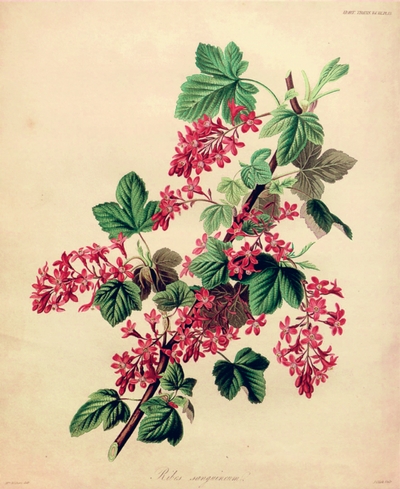
Flowering currant, botanical illustration
In Ribes sanguineum, sometimes called flowering blackcurrant, they are slightly downy underneath. Dark green to light green, the foliage of some flowering currants turns coppery yellow or red to purple in autumn before falling.
From late winter, as the leaves are just beginning to emerge, the flowering currant is remarkable for its graceful and abundant early flowering on still almost bare branches. From March to May, depending on the climate, a myriad of small tubular flowers with prominent stamens, composed of five petals, gathered in compact, pendulous clusters 2 to 10 cm long, appear.
Most often carmine pink, they come in yellow shades (Ribes alpinum), pure white in Ribes ‘White Icicle’ still too rare, or bright red mottled with peach and cream in Ribes gordonianum.
Branches with barely opened flowers will make lovely spring bouquets or graphic ikebana arrangements, those Japanese bouquets with clean lines.
Nectar-rich, this fragrant flowering emits a fruity scent of blackcurrant or carnation.
It is sometimes followed, from summer to autumn, by small blue-black, powdery berries, edible but tasteless, only appreciated by birds. Ribes x gordonianum does not produce fruit.
The flowering currant shows great hardiness, easily withstanding temperatures down to -25°C. It will thrive in partial shade or non-scorching sun, in ordinary, deep soil, not too chalky, rich and well-drained, remaining cool in summer.
It finds its place in all gardens, in a mixed hedge, in a shrub border, or even as a specimen plant combined with bulbs or spring biennials. It also adapts to container growing for the terrace.
Read also
How to prune early-flowering shrubsSpecies and main varieties
While the Ribes genus includes over 150 species, only a few are commercially available. Ribes sanguineum, the flowering currant, is the most commonly cultivated species in our gardens. It comes in numerous cultivars that have expanded the colour range from the pure white ‘White Icicle’ to the crimson rose-red ‘King Edward VII’.
The Most Popular
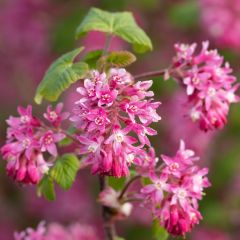
Ribes sanguineum - Flowering Currant
- Blütezeit April, May
- Höhe bei Reife 3 m

Ribes sanguineum King Edward VII - Flowering Currant
- Blütezeit April, May
- Höhe bei Reife 2 m
Our Favourites
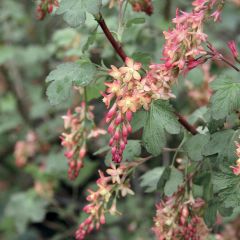
Ribes gordonianum - Gordon's Currant
- Blütezeit May, June
- Höhe bei Reife 1,80 m
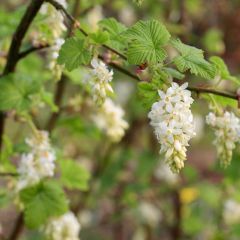
Ribes sanguineum White Icicle - Flowering Currant
- Blütezeit April, May
- Höhe bei Reife 2,50 m
Planting
Where to plant flowering currant?
Flowering currant can be planted throughout France, except perhaps in Mediterranean climates, which may be too hot and dry in summer. Highly hardy, it can easily withstand very low temperatures down to -25°C, ensuring perfect resilience in all regions.
Plant it in a sheltered spot, in full sun where it flowers best, but in a non-scorching position, especially in warmer regions where it will appreciate light shade.
Undemanding, it thrives in any good garden soil that is moist and not too chalky, provided it is well-drained as it dislikes winter wet. It prefers fairly rich soil that remains moist in summer: humus-rich, moist soil prevents branch desiccation. Once established, it tolerates drought well, especially in deep soil.
As a backdrop to a perennial border or among spring-flowering shrubs, as a standalone specimen, in a flowering hedge or in a pot on the terrace, flowering currant is compact and adapts to all gardens.
Planted in groups of 3 or 5, flowering currant is ideal for natural or country hedges, forming an elegant, fragrant floral screen.
When to plant ribes?
Flowering currant is best planted in autumn during September-October to encourage root establishment before winter, avoiding periods of severe frost.
How to plant flowering currant?
In the ground
For hedges, space plants at least 80 cm to 1 m apart.
- Soak the rootball in a bucket of water
- Clear the soil of stones, roots and weeds
- Loosen the soil well
- Gently tease out the rootball
- Dig a hole three times the size of the rootball
- Add a generous layer of pumice, river sand or gravel to the base
- Enrich with well-rotted compost
- Plant the shrub at soil level, centred in the hole
- Backfill, keeping the shrub upright
- Firm the soil around the base
- Mulch to keep roots cool and weed-free in summer
- Water thoroughly after planting, then weekly during the first growing season
Container cultivation
Choose a wide, deep pot at least 50 cm in diameter. Repot every 2-3 years in autumn.
- Drain the base with a 20 cm layer of clay pebbles
- Use good potting compost or a 50:50 mix of multipurpose compost and garden soil
Care and Maintenance
Easy to grow, Flowering Currant requires little maintenance. While this shrub adapts easily to all soil types, it prefers moist soils, not too dry. In summer, water once or twice a week during heatwaves. To keep the base cool during the growing season, apply a good organic mulch before spring, especially in the first few years after planting. After that, it will become more drought-resistant.
Adding well-rotted compost or organic fertiliser in autumn improves its growth.
Potted flowering currants require more regular watering: keep the soil moist but not waterlogged throughout the growing season. Fertilise with a liquid feed once a month during the entire growth period. In winter, reduce watering.
How to prune a flowering currant?
Pruning the flowering currant is not essential, except to balance its shape, remove dead wood, thin out the branches, or correct a somewhat sparse habit. There’s no need to prune every year. Pruning must be done immediately after flowering.
Maintenance pruning:
Every year, on young plants, remove any weak shoots and thin branches, as well as dead wood on older shrubs.
Rejuvenation pruning:
For shrubs older than three years that are becoming bare, prune one-third of the stems every two years to encourage the growth of new shoots.
You can also carry out a hard prune every 4-5 years, cutting back the oldest stems to 50 cm from the ground to rejuvenate the shrub and stimulate new growth.
→ Learn more about pruning flowering currants in our tutorial!
Diseases and potential pests
When grown under good conditions, the flowering currant is highly resistant to diseases and pests. However, it may occasionally be affected by rust, which covers the foliage with orange pustules, and powdery mildew, which whitens, dries out, and causes premature leaf drop: spray with a comfrey manure solution and/or a nettle infusion or garlic decoction.
During hot, dry weather, red spider mites may attack the foliage, turning the leaves greyish before they eventually fall. Spray with soapy water or rinse the foliage with cold water in the evening.
Propagation: How to take cuttings from a flowering currant?
Flowering currant can be easily propagated by semi-ripe cuttings in August-September or hardwood cuttings taken in December. It tends to layer naturally: simply take these rooted stems and replant them immediately in the chosen location.
By semi-ripe cuttings
- In late summer, take a 10-15 cm tip cutting from this year’s semi-ripe growth (meaning it’s in transition from softwood to hardwood), cutting just below a bud
- Make a 5 cm long slit in the bark
- Remove leaves from the lower third
- Plant them about 7 cm deep in a well-draining mix of sand and compost
- Keep the substrate moist until rooting occurs under a cold frame
- Transplant your cuttings into pots the following spring
- Allow the young plants to harden off in individual pots for at least one year before final planting in the garden
Pairing
Highly prized for its abundant and luminous flowering that begins in early spring, the Flowering Currant thrives in all natural and rustic gardens, creating wonderfully spring-like or romantic scenes. It pairs beautifully with a multitude of perennials, bulbs, and early-flowering shrubs.
Planted in groups of three or four, it can be combined with other varieties of False Currant or other flowering hedge shrubs, such as lilacs, a ‘Hollandia’ broom, a Syringa microphylla ‘Superba’, a Kerria japonica, or a Prunus persica Taoflora Pink.
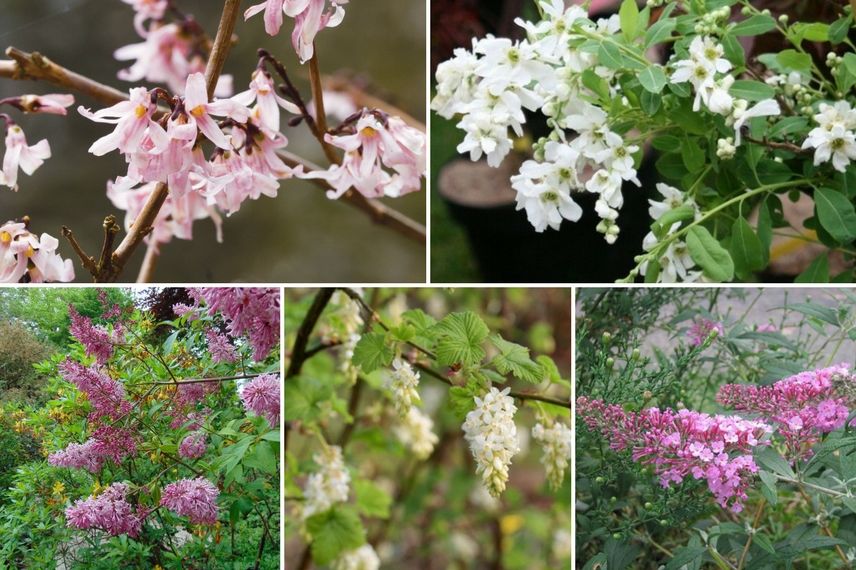

An example of a very “girly” hedge combination for staggered flowering from February to September: Abeliophyllum distichum ‘Roseum’ – Exochorda macrantha ‘The Bride’ – Syringa microphylla ‘Superba’ – Ribes sanguineum ‘White Icicle’ – Buddleia davidii ‘Pink Delight’
The bright pink blooms of Ribes ‘King Edward VII’ complement those of forsythias, Abeliophyllum distichum ‘Roseum’, and Japanese quinces.
It pairs wonderfully with spring bulbs such as daffodils, grape hyacinths, and tulips.
The Flowering Currant also works well with purple-foliaged perennials like bugleweed and alkanet, or purple-flowering plants such as Vinca minor and Symphytum officinale.
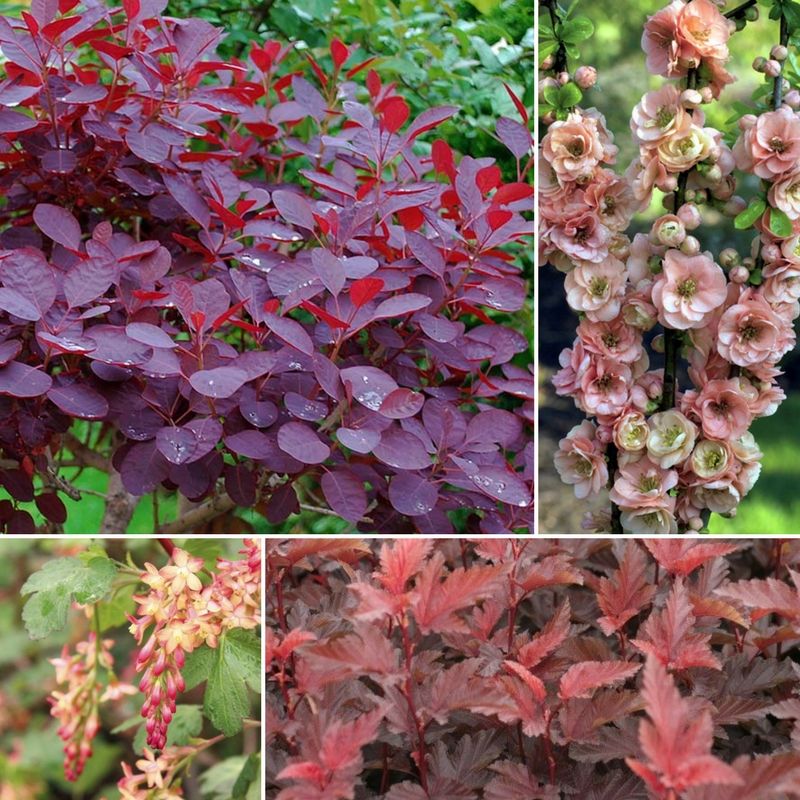

An example of a purple and salmon-toned hedge pairing: Cotinus coggygria ‘Royal Purple’ – Chaenomeles superba ‘Cameo’ – Ribes gordonianum – Physocarpus opulifolius ‘Lady in Red’.
Fairly unremarkable after late spring, be sure to surround it with companions that will take over its flowering display, such as buddleias, Mexican orange blossom, or an Exochorda macrantha ‘The Bride’. Later in the season, it will happily host a honeysuckle or a summer-flowering clematis.
Useful resources
- Discover the most beautiful flowering currants, some of which are exclusive to us!
- Check out our 5 ideas for pairing flowering currants
Frequently asked questions
-
In my garden, I have a flowering currant bush, its leaves are turning yellow – is this a disease?
If the leaves of the flowering currant become discoloured, turning yellow while the veins remain green, your shrub is likely showing signs of excessive lime in the soil. Add some ericaceous compost by lightly forking it in around the base to restore the pH balance.
- Subscribe!
- Contents



































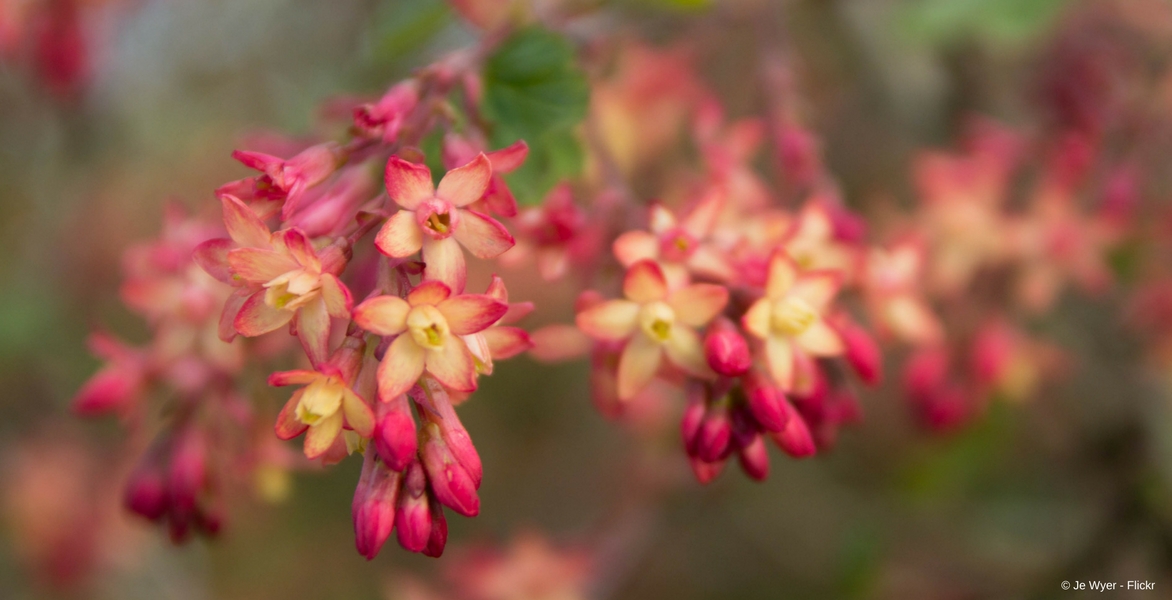

Comments